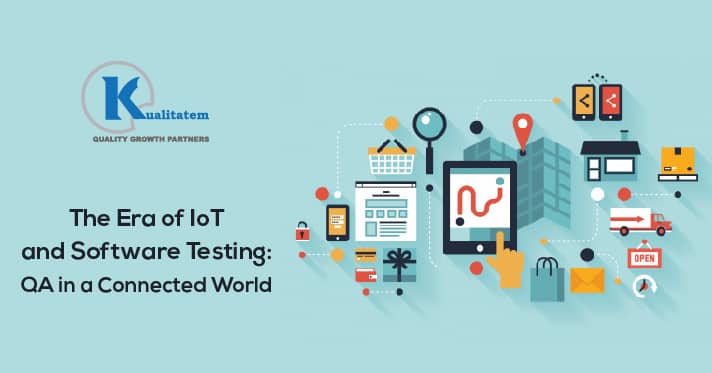The Era of IoT and Software Testing: QA in a Connected World

- June 25, 2019
- HibaSulaiman
Today is the era of the Internet of Things (IoT). In the year 2017, the number of connected devices exceeded the total population of humans on this planet. Yes, the number was 8.4 billion. However, Gartner expects this to almost triple by 2020 amounting to 20.4 billion.
With the influx of such a number of devices in our lives, we’re experiencing both good and bad outcomes.
Potential Security Vulnerabilities of IoT Devices
When people buy IoT devices, they commonly observe that many users report complains. For instance, people who have connected webcams, reportedly face cybersecurity issues. The privacy issues with these connected devices are way too many and the stats don’t help either. Many research firms have put forth alarming stats of home and office devices susceptible to cyber-attacks. For instance, many parents have reported instances of hackers actually gaining access to their baby monitors. By gaining access to these footages hackers can ask for ransom and more. They can publish these footages online as well. Moreover, intimate moments of family members can also be published online and result in defamation. This is quite an alarming situation.
Security of IoT Devices in Perspective
We are moving towards an era of smarter cities. Our homes and offices are literally way smarter than they were earlier by the courtesy of the huge influx of smarter devices. Security issues in IoT devices are a huge cause of concern for both manufacturers and users. Connected homes and offices do certainly make our lives easier but apparently, this ease comes with a huge price; that of privacy breaches and data losses. At the same time, these connected devices are not so simple and they are far more complex than what an average man perceives them to be. They connect to Wi-Fi, store data in AWS, charge our credit cards, and the list goes on. Unfortunately, we take this for granted and so do the manufacturers, at times. Often there is a flaw in the software the IoT device is running on. It is of extreme importance to hire a partner for quality software testing services to ensure that the software is immaculate. Next is the importance of information security and cybersecurity.
Interestingly or alarmingly, there are more and more connecting points for IoT devices. Increased connectivity simply means an increased risk of data compromise, privacy breaches and hacking.
Software Testing & The Era of IoT
The security threats are not ending anytime soon. The number of IoT devices is growing exponentially and so are the potential security vulnerabilities. Quality assurance and software testing have to evolve in order to meet the upcoming challenges.
To help you take your quality assurance activities to the next level, here are three critical ways that can help you evolve your testing approach in this era of IoT:
1) Continuous Security Testing
There are so many points of connection in IoT and this is one of the reasons that IoT devices are so vulnerable to security attacks. It’s very easy to lose track of what is happening in these points at any given point of time. However, with continuous security testing, this can be changed.
Most teams conduct security and load testing at the end of the development process. At this stage, they have completed all their unit and functional tests. For best results, testing teams have to conduct security testing earlier into the software development process to get benefits quickly.
According to a recent survey of Fortune 500 CEOs, the rapid pace of technology change and cybersecurity are the top two concerns. See, how these top two concerns correlate easily with the current and disruptive era of IoT. Development teams have to work with a fast pace and ensure interconnectivity to see that all protocols work efficiently and that there are no weak points in the system. It is, therefore, imperative that testers seek benefits from continuous security testing.
2) Test Prioritization
IoT devices are complex and obviously one needs to conduct thorough testing for optimum results. However, when you opt for continuous security testing and DevOps, it is very important to decide what needs not to be tested.
Not everything is to be tested for each release. Do this without sacrificing your security concerns and this will help you maintain proper test coverage and ease up the pressure around tight deadlines.
As you single out the areas of the software that you do not need to test during every release, maintain a record of protocols that you have already tested and will remain the same in subsequent releases. If you do this, you will be able to cut down on a lot of time investment for the project and ensure quicker product releases.
3) Service Virtualization
To have a production-like environment for test automation plays a vital role. This is, however, difficult to achieve since most of the times the interconnected systems on which IoT apps work on are not readily available. A lot needs to be working and in place for a proper testing environment.
Service virtualization or a production-like virtual environment is a necessity today. The virtual environment might not be a copy of the actual one, it still might play a great role in helping your team move the software to production.
A strong service virtualization strategy will help you avoid bottlenecks for testing every minute change. Moreover, it will also make you believe in all of your releases.
Final Word
IoT is here and it is here to stay. To cope up with the disruption at hand, companies have to adapt to it. IoT has many great prospects but companies have to come full circle when it comes to their testing game to reap maximum benefits. It is time to evolve QA practices by ensuring continuous security testing, test prioritization, and service virtualization.











